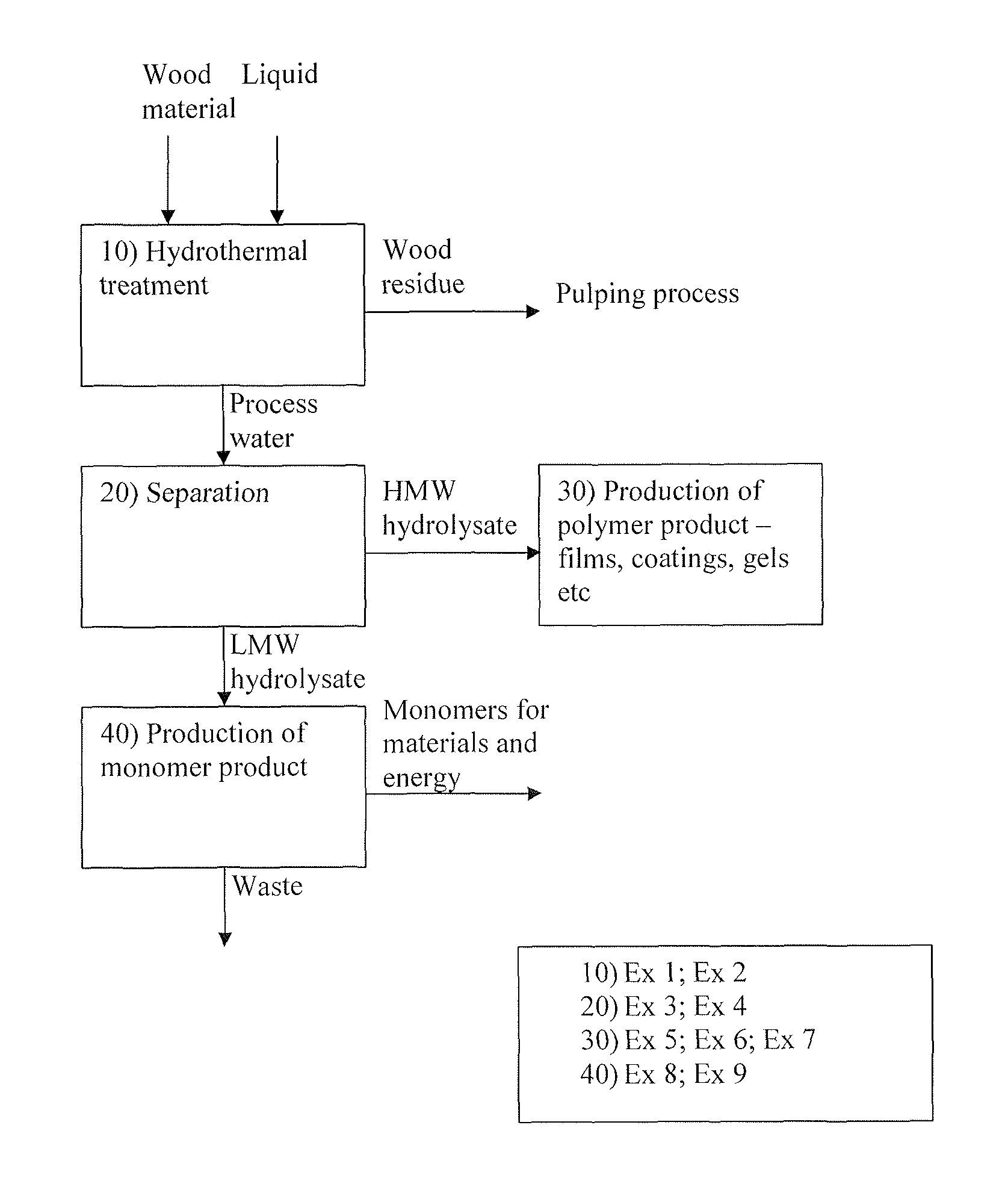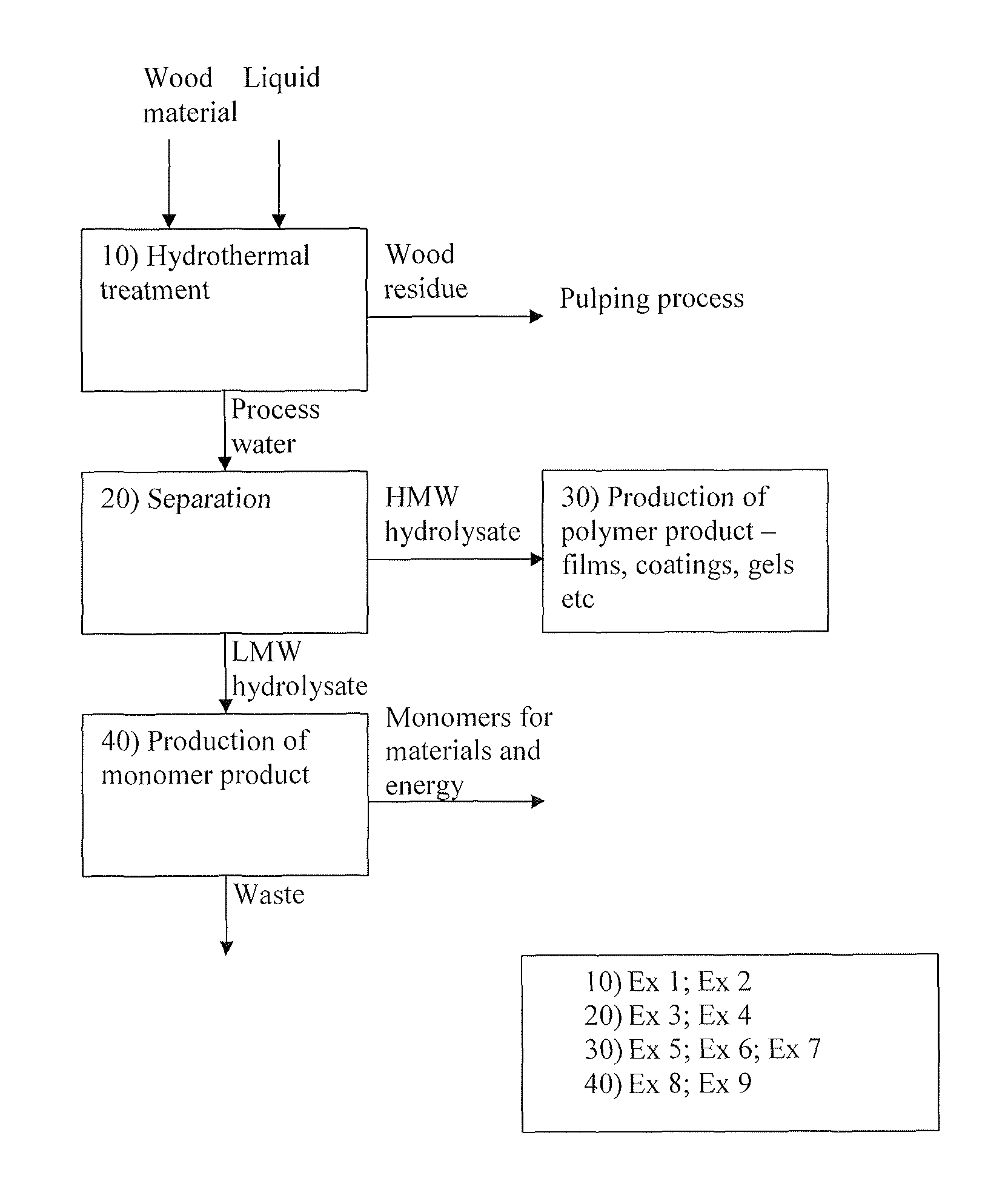Utilization of a wood hydrolysate
a hydrolysate and wood technology, applied in the field of utilizing a hydrolysate, can solve the problems of saving cost by avoiding the use of acid or alkali, and achieve the effect of good film or coating properties
- Summary
- Abstract
- Description
- Claims
- Application Information
AI Technical Summary
Benefits of technology
Problems solved by technology
Method used
Image
Examples
example 1a
[0062]Industrial chips (2.3 kg), obtained from spruce (Picea abies) with a dry content of 42% and screened on a laboratory screen passing 8 mm but not 2 mm, was charged to a continuous liquid flow autoclave. Hot water (4.6 L, L=litres) preheated to 165° C. was flushed into the autoclaves from a pressurized vessel connected to the autoclave to give a treatment liquid-to-wood ratio 6:1 (volume to mass ratio). The autoclave was kept at 165° C. for 30 minutes hydrothermal treatment of the wood material. Then a portion of the treatment liquid (˜4.5 L) was displaced during approximately 5 minutes by the corresponding volume preheated fresh water. The hot (165° C.) wood hydrolysate liquid displaced was collected in a second pressurized vessel connected to the autoclave. The hydrothermal wood treatment was then continued in the autoclave with the fresh hot water portion for an additional 30 minutes after which also this second wood hydrolysate liquid was displaced into the pressurized colle...
example 1b
[0063]Example 1B was conducted in a similar manner as Example 1A, industrial spruce chips (2.3 kg, with a dry content of 42%) from the same laboratory screened batch was charged to the continuous liquid flow autoclave. Also in this case hot water (4.6 L) preheated to 165° C., was flushed into the autoclaves from a pressurized vessel to give a treatment liquid-to-wood ratio 6:1 (volume to mass ratio). However, this time the hydrothermal treatment was carried out for 60 minutes at 165° C. before displacing the wood hydrolysate liquid with fresh preheated water. The displaced wood hydrolysate liquid was collected in the pressurized vessel. The hydrothermal treatment of the wood material was continued with the fresh water portion in the autoclave for 30 minutes. Finally, this second wood hydrolysate liquid was displaced into the pressurized collection vessel and combined with the first hydrolysate. The total volume of the wood hydrolysate obtained was 10.3 L and the pH 3.8. The total yi...
example 1c
[0064]Dried industrial chips (1.0 kg), obtained from birch (Betula verrucosa) with a dry content of 90% and screened on a laboratory screen passing 8 mm but not 2 mm, was charged to a continuous liquid flow autoclave. Hot water (5.5 L, L=litres) preheated to 165° C. was flushed into the autoclaves from a pressurized vessel connected to the autoclave to give a treatment liquid-to-wood ratio 6:1 (volume to mass ratio). The autoclave was kept at 165° C. for 30 minutes hydrothermal treatment of the wood material. Then a portion of the treatment liquid (˜4.5 L) was displaced during approximately 5 minutes by the corresponding volume preheated fresh water. The hot (165° C.) wood hydrolysate liquid displaced was collected in a second pressurized vessel connected to the autoclave. The hydrothermal wood treatment was then continued in the autoclave with the fresh hot water portion for an additional 30 minutes after which also this second wood hydrolysate liquid was displaced into the pressur...
PUM
| Property | Measurement | Unit |
|---|---|---|
| pH | aaaaa | aaaaa |
| pH | aaaaa | aaaaa |
| pH | aaaaa | aaaaa |
Abstract
Description
Claims
Application Information
 Login to View More
Login to View More - R&D
- Intellectual Property
- Life Sciences
- Materials
- Tech Scout
- Unparalleled Data Quality
- Higher Quality Content
- 60% Fewer Hallucinations
Browse by: Latest US Patents, China's latest patents, Technical Efficacy Thesaurus, Application Domain, Technology Topic, Popular Technical Reports.
© 2025 PatSnap. All rights reserved.Legal|Privacy policy|Modern Slavery Act Transparency Statement|Sitemap|About US| Contact US: help@patsnap.com


